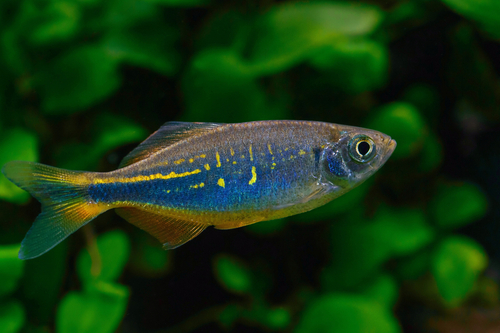Looking far and wide for suitable neighbors for your giant danios? With such a large fish, this can be overwhelming! Luckily, we have you covered with a list of the greatest tank mates for your fish.
The Best Giant Danio Tank Mates are fish that can coexist easily with the danio without competing too aggressively for food or space, as well as existing in the same parameters of tank and temperature. Some of these include Three Stripe Cory Catfish, tiger barbs, and other species of danio.
In this article we’ll show you all 15 of our top picks in terms of giant danio aquarium buddies. Let’s get started!
Contents
Giant Danios Tank Mates – What You Need to Know
There are a few things that are absolutely essential to understand about your Giant Danios, and the tank mates you hope to get for them. Let’s take a look at these below!
Temperament
Temperament merely means how your fish is predisposed to respond to any kind of stimulus. If your fish is more aggressive and territorial, it should be kept with others that can hold their own and withstand bullying. If your fish is shy or peaceful, it should be kept with other sensitive fish.
A giant danio is naturally peaceful, a gentle giant. It should be kept with others that exhibit the same temperament!
Size
When talking about giant danio tank mates, size is important! As per their name suggests, Giant Danios are large. They need other fish that are about their same size or a bit larger to avoid snacking on one another. However, bear in mind that you’ll need a large tank to accommodate these, since giant danios like to be kept in schools of their own big kind, too!
Competition
Competition mainly refers to the food that two different types of fish may compete for. Some fish can handle a little friendly race to their favorite food source, but others find it too much stress and can starve with the wrong tank mates.
Giant Danios should be kept with fish that eat at a different time or different diet than themselves. They eat frozen and live foods like brine shrimp and larvae, being omnivores. Try tank mates that are herbivores or eat at the bottom of the tank.
Parameters ; Tank Setup
Giant danios need plenty of room in their tank, with about 55 gallons for 1 and an additional 5 to 10 gallons per extra fish! They also need a temperature range of 72 to 81 degrees Fahrenheit.
15 Best Giant Danios Tank Mates
The top best giant danios tank mates can be found in our list below!
- Tiger Barb
- Three Stripe Cory Catfish
- Rosy Barb
- Red Wagtail Platy
- Suckermouth Catfish
- Dwarf Spotted Danio
- Agassiz’s Dwarf Cichlid
- Clown Pleco
- Golden Angelfish
- Cardinal Tetras
- White Cloud Mountain Minnow
- Mystery Snail
- Swordtail
- Blue Lyretail Killifish
- Kuhli Loach
Time to dive in and see what makes these tank mate options so great!
Also check out:
- Chinese Algae Eater Tank Mates
- Jaguar Cichlid Tank Mates
- Salvini Cichlid Tank Mates
- Congo Tetra Tank Mates
1. Tiger Barb
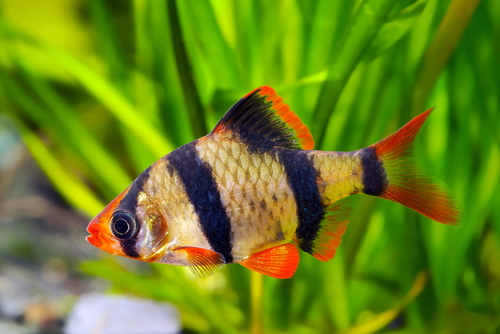
- Scientific Name: Barbus tetrazona
- Adult Size: 3 inches
- Compatible With: Giant Danios
- Care Level: Easy
- Origin: Sumatra
Tiger Barbs are no end of fun in your aquarium! They may be small, but they are peaceful and active in nature. They love to be kept in schools of their own kind, and though they are energetic and fun to watch, they pose no threat to your giant danios.
Their stripes and fast-moving mannerisms make them a pleasing visual contrast to your giant danios. Not only that, but they are perfect for entertaining yourself by watching them play tag.
Pros of keeping with Giant Danios:
- No aggression
- No food competition
Cons of keeping with Giant Danios :
- None
2. Three Stripe Cory Catfish
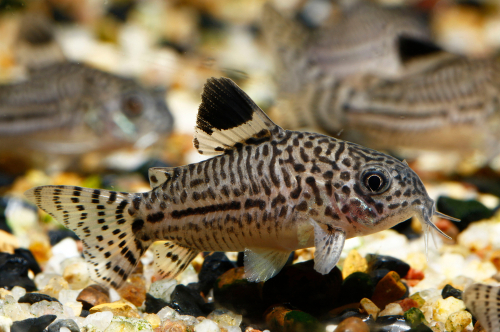
- Scientific Name: Corydoras trilineatus
- Adult Size: 2.5 inches
- Compatible With: Giant Danios
- Care Level: Easy
- Origin: Amazon
The three stripe cory catfish is noticeable for the stripes that give it its name. They are also known as “leopard cory,” because of their speckled-to-spotted patterns of striped markings. They also have large eyes and an adorable size compared to giant danios.
Despite their sizing, they are bottom dwellers who will not be likely to be eaten by giant danios. That, and their peaceful nature, make them great tank mates.
Pros of keeping with Giant Danios:
- No aggression
- No food competition
Cons of keeping with Giant Danios :
- None
3. Rosy Barb
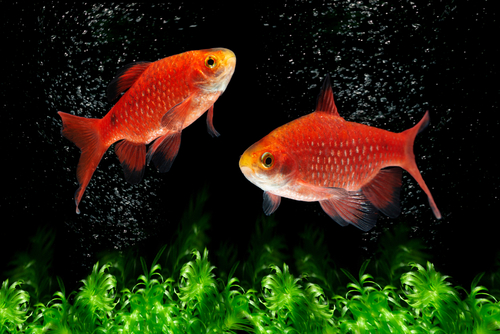
- Scientific Name: Puntius conchonius
- Adult Size: 6 inches
- Compatible With: Giant Danios
- Care Level: Easy
- Origin: India
Looking for some fire in your aquarium? The rosy barb has that to offer in it’s bright ruby coloration! It will make a great companion, visually, to your giant danios, both in size and color.
Rosy barbs are popular for their looks and their active but peaceful habits. They will not harm your giant danios, but they are too quick and a bit too large to be eaten, too!
Pros of keeping with Giant Danios:
- No aggression
- No food competition
Cons of keeping with Giant Danios :
- None!
4. Red Wagtail Platy

- Scientific Name: Xiphpophorus maculatus
- Adult Size: 3 inches
- Compatible With: Giant Danios
- Care Level: Easy
- Origin: Mexico
The red wagtail platy is another fish with bright coloring that can spice up your big giant danio tank. They come in several different colors, including black and white and the classic red with dark fins.
This fish enjoys being social with plenty of tank mates, as long as they all have similar peaceful natures! Luckily, this makes them excellent for giant danios.
Pros of keeping with Giant Danios:
- No aggression
- No food competition
Cons of keeping with Giant Danios :
- None!
5. Suckermouth Catfish
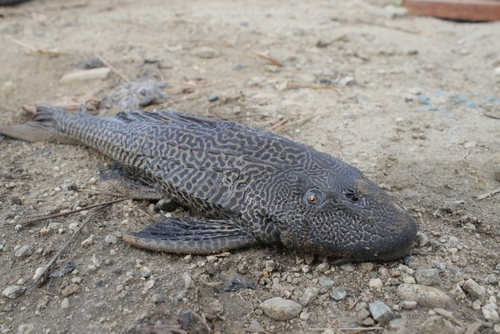
- Scientific Name: Hypostomous plecostomous
- Adult Size: 2 feet
- Compatible With: Giant Danios
- Care Level: Easy
- Origin: South America
This peaceful catfish rivals the giant danio in size, but don’t worry! It will not pose a thread to the danio. This is because it occupies the bottom of the tank and is generally peaceful.
Suckermouth catfish also please their owners by eating plants and enjoying their swim as long as they’ve got enough space. They won’t compete with danios for food, and they come in a dark, speckled pattern of color with long fins.
Pros of keeping with Giant Danios:
- No aggression
- No food competition
Cons of keeping with Giant Danios :
- None!
6. Dwarf Spotted Danio
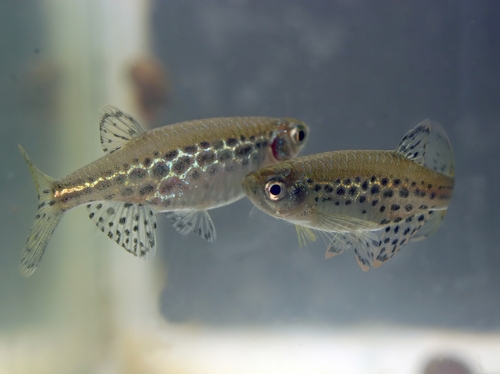
- Scientific Name: Danio nigrofasciatus
- Adult Size: 2 inches
- Compatible With: Giant Danios
- Care Level: Easy
- Origin: Myanmar
Dwarf spotted danios, also known as spotted brown fish, are aptly named for their drab color. However, under a light, they are bold and iridescent, with some blues and whites hidden under the dark color!
Dwarf spotted danios are peaceful, but shy. They will be happy to swim around with small species, and even though giant danios can be large and intimidating to them, they’ll be fine as long as they have somewhere to hide.
Pros of keeping with Giant Danios:
- No aggression
- No food competition
Cons of keeping with Giant Danios :
- Can become intimidated without enough hiding places
7. Agassiz’s Dwarf Cichlid
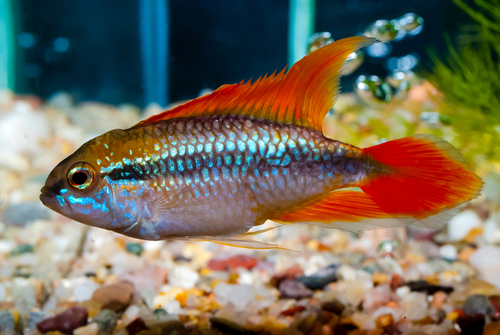
- Scientific Name: Apistogramma agassizii
- Adult Size: 2 inches
- Compatible With: Giant Danios
- Care Level: Easy
- Origin: South America
This cichlid originated in South America, and has been beloved in aquarium circles ever since for its bright yellow, blue, and silver colors. It is striped, with long yellow fins, dark eyes, and a diminutive size.
However, these fish are still fast and careful enough to avoid any mishaps with giant danios. They are shy in temperament, meaning they are unlikely to cause any trouble and keep to themselves in large tanks!
Pros of keeping with Giant Danios:
- Not aggressive
- No food competition
Cons of keeping with Giant Danios :
- None!
8. Clown Pleco
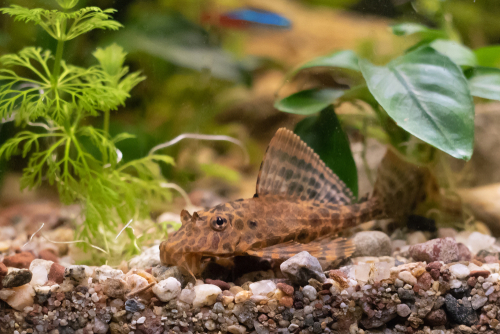
- Scientific Name: Panaqolus maccus
- Adult Size: 3 inches
- Compatible With: Giant Danios
- Care Level: Easy
- Origin: Columbia, Venezuela
The clown pleco will add another great visual difference to your giant danio tank. It may be dark in color, but it can also come in silvery white and black stripes, too. It dwells on the bottom of the tank, so there is nothing to fear in terms of territorial disputes.
In terms of temperament, it is also peaceful. The clown pleco enjoys feeding on substrate, and loves its veggies, so there really won’t be any problems when it comes to food competition, either.
Pros of keeping with Giant Danios:
- No food competition
- No aggression
Cons of keeping with Giant Danios :
- None!
9. Golden Angelfish

- Scientific Name: Centropyge aurantia
- Adult Size: 6 inches
- Compatible With: Giant Danios
- Care Level: Easy
- Origin: Indonesia
Hailing from Indonesia and the Great Barrier Reef, the golden angelfish is a big, round, pleasing shape to add to your aquarium. This fish comes in a reddish, burnt sort of color, and is almost completely round in silhouette save for its brightly colored lips.
Golden angelfish are peaceful fish, and they are not likely to bother your giant danios or compete too harshly for food. It is a joy to see them cruising along the tank like large sails!
Pros of keeping with Giant Danios:
- No aggression
- No food competition
Cons of keeping with Giant Danios :
- None
10. Cardinal Tetras
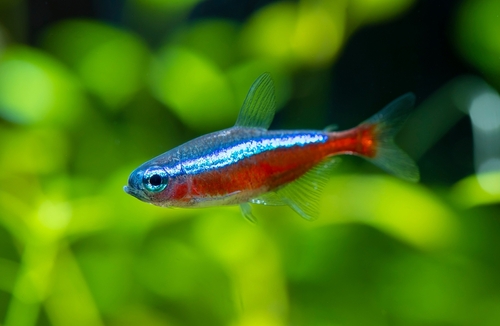
- Scientific Name: Paracheirodon axelrodi
- Adult Size: 2 inches
- Compatible With: Giant Danios
- Care Level: Medium difficulty
- Origin: Colombia, Brazil, Venezuela
Cardinal Tetras are well-known for their popularity and ease of acquisition in aquarium communities. They may be very small, but they tend to school in fast-moving groups that are unlikely to be eaten by giant danios.
Cardinal tetras are bright reddish pink, with white bellies and an iridescent, neon blue capping their bodies. Their fins are nearly transparent.
Pros of keeping with Giant Danios:
- Not aggressive
- Fast enough to avoid being eaten
Cons of keeping with Giant Danios :
- None
11. White Cloud Mountain Minnow
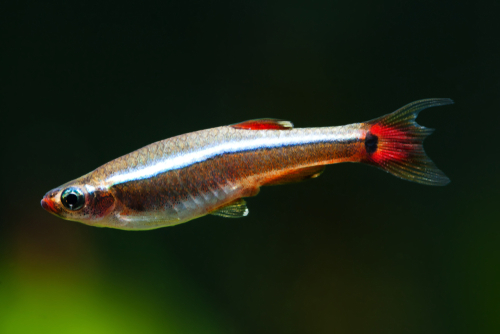
- Scientific Name: Tanichthys albonubes
- Adult Size: 1 ½ inches
- Compatible With: Giant Danios
- Care Level: Easy
- Origin: White Cloud Mountains in China
This fascinating little minnow is only found in a specific place in the wild. It is generally a great fish for those who are just beginning their aquarium-building journey due to ease of care. It is a sociable, friendly little species with no bad attitude problems!
Living mainly in the bottom and top of the tank, this small fish will not interest or annoy your giant danios. It is a pale silver with a hint of blue in coloration, most noticeable in a blue stripe from the eye to the tail fin.
Pros of keeping with Giant Danios:
- No aggression
- No food competition
Cons of keeping with Giant Danios :
- None!
12. Mystery Snail

- Scientific Name: Pomacea bridgesii
- Adult Size: 1 ½ inches
- Compatible With: Giant Danios
- Care Level: Easy
- Origin: Asia
If you need a little variety in your tank, look no further than the mystery snail! Not only will it be of no interest to hungry giant danios, but it provides a great break from fish. Mystery snails typically stay on the plants or substrata of the tank.
Obviously, with a snail, there is no need to worry about food competition! You’re also never going to see a mystery snail bullying your danios any time soon.
Pros of keeping with Giant Danios:
- No aggression
- No food competition
Cons of keeping with Giant Danios :
- None!
13. Swordtail
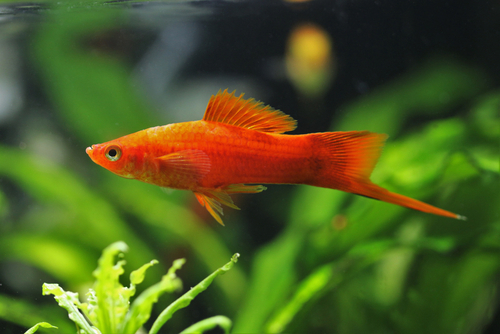
- Scientific Name: Xiphophorus helleri
- Adult Size: 3 inches
- Compatible With: Giant Danios
- Care Level: Easy
- Origin: Central America
A swordtail from Central America will add the opposite side of the color and size spectrum to your giant danios tank. It is blue with yellow stripes and sporty, long fins.
Swordtails are peaceful by nature, but they are active and interesting enough to watch to keep your eye on the tank!
Pros of keeping with Giant Danios:
- Not aggressive
- No food competition
Cons of keeping with Giant Danios :
- None!
14. Blue Lyretail Killifish
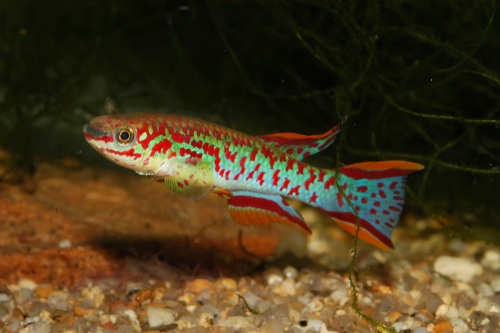
- Scientific Name: Fundulopanchax gardneri
- Adult Size: 2 inches
- Compatible With: Giant Danios
- Care Level: Easy
- Origin: Central America
A splash of beautiful, eye-catching color is what you’ll get with this killifish. Though it is small, it will be too quick to be caught or harmed by your giant danio.
This fish comes in a beautiful range of pale colors with stricking speckles, and of course, blue color blending! Without having to worry about food competition, this fish makes a great tank mate for giant danios.
Pros of keeping with Giant Danios:
- No aggression
- No competition
Cons of keeping with Giant Danios :
- None!
15. Kuhli Loach

- Scientific Name: Pangio kuhlii
- Adult Size: 3 inches
- Compatible With: Giant Danios
- Care Level: Easy
- Origin: Indonesia
Kuhli loaches are another fantastic source of visual difference for your tank of giant danios. Instead of a regular fish shape, this loach is long and slender, more like a snake. It also sports a brown-to-yellow pattern of splotches.
Kuhli loaches are not likely to be eaten or threaten giant danios in any way, and their size is well accommodated by giant danio tanks!
Pros of keeping with Giant Danios:
- No aggression
- No food competition
Cons of keeping with Giant Danios :
- None
In Conclusion
In conclusion, the 15 best Giant Danios Tank Mates include loaches, barbs, and even swordtails. Despite their large size and many of these tank mates’ smaller size, as long as you have peaceful fish that are either quick or able to hide, there’s no reason to fear a disruption of the peace!

Ian Sterling, founder of Fishlab.com, began his aquarium journey over 30 years ago, driven by a deep fascination for fish and their diverse personalities. His website, Fishlab.com, is dedicated to making fishkeeping accessible and enjoyable, offering beginner-friendly guidance, expert insights, and a community for aquarists to connect and share experiences.


